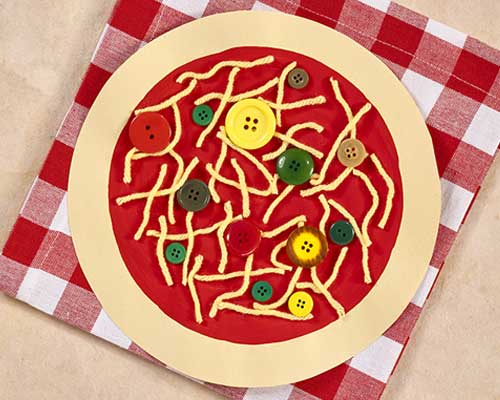Loose Parts Pizza

Create delicious pizzas out of loose parts and paint.
Then serve them to peers and grownups for lots of imaginative fun!
What are loose parts? Loose parts are open-ended and versatile materials that can be used in a variety of ways. They can be found, bought, taken out of your recycling bin, or even taken from other art projects and repurposed. With loose parts children can use their imaginations to create in endless ways. Some examples of loose parts can be found in our materials list below.
Create delicious pizzas out of loose parts and paint. Then serve them to peers and grownups for lots of imaginative fun! What are loose parts? Loose parts are open-ended and versatile materials that can be used in a variety of ways. They can be found, bought, taken out of your recycling bin, or even taken from other art projects and repurposed. With loose parts children can use their imaginations to create in endless ways. Some examples of loose parts can be found in our materials list below.
Ages/Grades
Preschool, Early Elementary
Learning Domains
Language, Fine Motor, Cognitive/Math & Science
Materials
• Cardstock or a sturdy piece of cardboard (white or tan)
• Glue
• Pom poms
• Scissors
• Other loose parts, like beads, feathers, cut craft stems (optional)
Ready, Set, Create!
![]() Cover your work surface with a tablecloth or table paper for easy cleanup.
Cover your work surface with a tablecloth or table paper for easy cleanup.
![]() For younger children, an adult should cut a piece of cardstock into a large circle shape. Older children may be able to trace a plate and cut out the circle on their own.
For younger children, an adult should cut a piece of cardstock into a large circle shape. Older children may be able to trace a plate and cut out the circle on their own.
![]() Place the yarn, buttons, and poms poms out on your work surface, grouped together.
Place the yarn, buttons, and poms poms out on your work surface, grouped together.
![]() For younger children, an adult can cut the yarn into pieces or hold the yarn out for children to snip. Older children can cut the yarn themselves.
For younger children, an adult can cut the yarn into pieces or hold the yarn out for children to snip. Older children can cut the yarn themselves.
![]() Mix equal parts glue and red paint in a shallow dish or paint cup and stir.
Mix equal parts glue and red paint in a shallow dish or paint cup and stir.
![]() Invite children to use a paintbrush to paint the paint and glue mixture “sauce” onto their pizzas.
Invite children to use a paintbrush to paint the paint and glue mixture “sauce” onto their pizzas.
![]() Encourage children to decorate their pizzas with yellow yarn “cheese” and button and pom pom “toppings.” When placed on the “sauce,” these items will stick since the paint has been mixed with glue. No additional glue needs to be added.
Encourage children to decorate their pizzas with yellow yarn “cheese” and button and pom pom “toppings.” When placed on the “sauce,” these items will stick since the paint has been mixed with glue. No additional glue needs to be added.
![]() Once dry, these pizzas can be used in imaginative play and taken over to the dramatic play area.
Once dry, these pizzas can be used in imaginative play and taken over to the dramatic play area.
Engage Children in Conversation
Place photographs around the work area of different types of pizzas. Add photos of different types of pizza from different cities around the world. The more toppings, the better!
Comment on what you observe, such as “I notice you glued on red buttons. What type of topping is that?” and “It looks like you added a lot of yarn.”
Ask children open ended questions that encourage critical thinking, such as:
Which color buttons will you use to make toppings? What types of toppings will you include?
Who will you serve your pizza to?
Where will your pizza be served? At home? At a restaurant?
Extensions
Place the completed pizzas in the dramatic play area. Children can write menus and serve pizza to each other.
At your Writing Center, add topical words such as “pizza,” “cheese,” etc. so that children can practice writing these words while making menus.
Take photos of the children and record their words while they are creating. Print these photos and words and create a display on the wall to go along with their pizzas.
In the Dramatic Play area, bring out materials typically found in a pizza restaurant, such as (child-sized) aprons, chef’s hats, pizza pans, and other restaurant items.
Modifications
![]() Try using large and easily graspable loose parts with the dough, as well as smaller pieces, so that children have a variety of options depending upon their motor abilities.
Try using large and easily graspable loose parts with the dough, as well as smaller pieces, so that children have a variety of options depending upon their motor abilities.
![]() Try providing large and easier grasped loose parts, as well as smaller pieces so that children have a variety of options depending upon their motor abilities. When using larger sized loose parts, children can refrain from touching the glue with their fingers when placing objects onto the paper.
Try providing large and easier grasped loose parts, as well as smaller pieces so that children have a variety of options depending upon their motor abilities. When using larger sized loose parts, children can refrain from touching the glue with their fingers when placing objects onto the paper.
